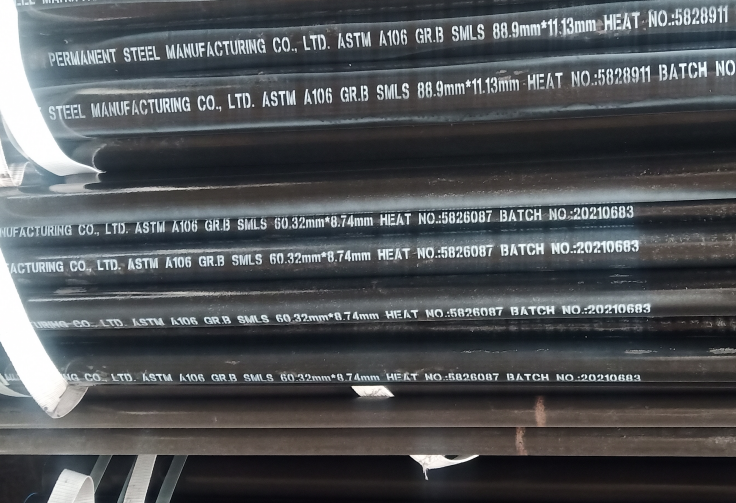
Analysis of the Causes of Common Defects in Seamless Steel Pipes
Date:2022-02-23 keywords: seamless steel pipes defects
Analysis of the causes of common defects in seamless steel pipes:
(1) Reasons for the irregular distribution of folding defects.
Improper viscosity of mold slag, obvious abnormality of molten steel vortex or abnormal vibration frequency of mold will cause slag entrainment. Most of the mold slag exists in the subcutaneous or surface area of the continuous casting billet, so there may be cracks or folding defects in the local area of a rolled tube.(2) Causes of the longitudinal distribution of large folding defects.
The casting temperature of the open casting furnace is high, and the liquid level of the mold fluctuates greatly, which will cause longitudinal cracks on the surface of the continuous casting billet. Due to the longitudinal defects of cracks on the surface of the billet, heating the billet in an annular heating furnace (1280°C) for two hours, the cracked part is severely oxidized and decarburized during high temperature heating, and the rolling process cannot be rolled, which will make the surface of the rolled pipe Deep fold defects appear.

(3) Causes of small crack defects.
The heating temperature and holding time of the seamless steel pipe in the annular furnace are relatively high, resulting in heavy oxidation and decarburization on the surface of the seamless steel pipe, and the matrix grains are relatively coarse. Since the microstructure of the decarburized layer is ferrite with low strength, it is easy to cause cuts or scratches when the pipe is rolled, so that the weak parts of the surface of the pipe that are severely decarburized will appear small crack defects in the subsequent rolling process.
(4) Causes of linear defects.
When the temperature is too low during rolling, the pass pattern of the reducer and the sizing machine is dislocated, the surface of the roll sticks to the steel, and the roller surface of the continuous rolling mill is excessively worn, which will cause the surface of the seamless steel pipe to be scratched during the process of high temperature travel, resulting in Linear defects.
(5) Causes of scarring defects.
a. When high-pressure water is used for phosphorus removal, the iron oxide scale on the surface of the seamless steel pipe is not completely removed, and these residual iron oxide scales will be pressed into the surface of the pipe in the subsequent process of rolling the pipe, thereby forming scars. After heat treatment , Most of the scabs will fall off, resulting in surface pit defects.
b. There are foreign objects, such as metal, attached to the surface of the pass, resulting in the formation of bumps on the surface of the pass, and pits appear on the surface of the steel pipe.
(6) Causes of quenching cracks.
Because the mold slag contains a large amount of carbon powder, the crystal vibration is abnormal and the slag is entrained, resulting in a local carbon increase in the continuous casting billet. When the seamless steel pipe is heat treated, high-carbon martensite will be formed in the carbonized part of the pipe body, while low-carbon martensite will be formed in the normal part. Due to the different r properties of the microstructure transformation, there will be large microstructure stress. , Once the stress exceeds the cracking limit of the seamless steel pipe, quenching cracks will occur in the high carbon martensite part.
(7) Causes of convex hull defects.
There are large-scale complex oxide segregation in the core of the continuous casting billet, and the large-scale inclusions will be rolled into long strips in the process of rolling and piercing. Due to the different deformability of the steel matrix and the inclusions, the final reduction of the rolled tube is caused. During the diameter and sizing process, the matrix of the inner wall of the seamless steel pipe is squeezed, so that there will be convex hull defects on the inner surface of the seamless steel pipe.
(8) Causes of straight-track defects.
1) When the rolling temperature and heating temperature of the tube blank are low, the mandrel or the plug is easy to stick to the metal, which will cause the inner surface of the seamless steel tube to be scratched. If the taper angle of the plug is too small, the plug is severely worn, and the ejector pin is bent, the plug will be deflected and the inner surface will be scratched.
2) If the mandrel is severely worn, the inner surface of the seamless steel pipe is easily scratched during the rolling process.
3) The graphite lubricant contains many impurities, which will cause the inner surface of the seamless steel pipe to be scratched during the rolling process.
News Update :
45° Short Radius Elbows and Long Radius Elbows...
©2017 Permanent Steel Manufacturing Co.,Ltd https://www.permanentsteel.com All Rights Reserved.
Terms of Sale|Privacy Policy


